- Home
- /
- Article




Set up Presenter and Audience on Board and Room Series
 In this article
In this article Feedback?
Feedback?The Presenter and Audience setup enables presenters to engage and inspire their audience in large rooms, and provides a seamless experience regardless of where you join the event from. This is the new era of hybrid events in the office.
In short, the Presenter and Audience setup is tailored for using a room to deliver hybrid events, such as training sessions or town halls. The setup is built around three modes: the presenter is in the room (local presenter), the presenter is on video (remote presenter), and there are presenters both in the room and on video (hybrid presenter). The device automatically detects where the presenter is and selects a mode based on that. Alternatively, you can override the automatic behavior and select the mode manually from the user interface.
Read the Using the Presenter and Audience setup article to find what's on which screen, what's sent to the far end, and what triggers automatic switching between the modes.
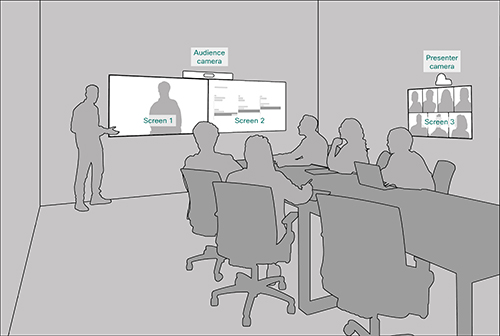
Requirements and limitations
Required equipment
One of the following devices:
-
Board Pro G2
-
Codec EQ (Room Kit EQ), Codec Pro (Room Kit Pro), and Codec Plus (Room Kit Plus)
-
Room Bar Pro
-
Room Kit EQX, Room 70 G2, Room 70, and Room 55 Dual
Two or three screens:
-
Screen 1: First screen, placed at the front. For integrated devices with two screens, screen 1 is the left screen.
-
Screen 2: Second screen, placed at the front. For integrated devices with two screens, screen 2 is the right screen.
-
Screen 3 (optional): Third screen, placed on the side or at the back, so that a local presenter can see the remote audience.
Two cameras:
-
Audience camera: Use the integrated camera for devices that have that. For other devices, we recommend a camera that supports speaker tracking, such as the Quad Camera. It's also possible to use a camera without speaker tracking capabilities.
-
Presenter camera: A PTZ 4K or Precision 60 camera with presenter tracking enabled.
Microphones:
-
You need microphones for good coverage of the stage, and microphones for good coverage of the room with the audience.
Loudspeakers
-
Use the integrated speakers for devices that have that. For other devices, we recommend good quality stereo speakers placed next to screen 1 and screen 2 at the front of the room.
Room Navigator
Limitations
-
Presenter and Audience works only for Webex Meetings and SIP calls.
Comparing Presenter and Audience to Briefing room and Classroom
Presenter and Audience is the next generation Briefing room and Classroom setups. Further updates and improvements to such setups will only be for Presenter and Audience. Briefing room and Classroom may be deprecated in a later software release.
With Presenter and Audience you get:
-
Easier manual layout selection options.
-
Improved camera switching based on voice activity detection.
-
Improved diagnostics tools, such as the diagnostics page that is available on the touch controller.
Connect the components
Connect the cameras and screens to the device as shown in the diagrams. When you follow the diagrams the configurations that are automatically pushed to the device when you select the Presenter and Audience room type, match your actual room setup.
Board Pro G2
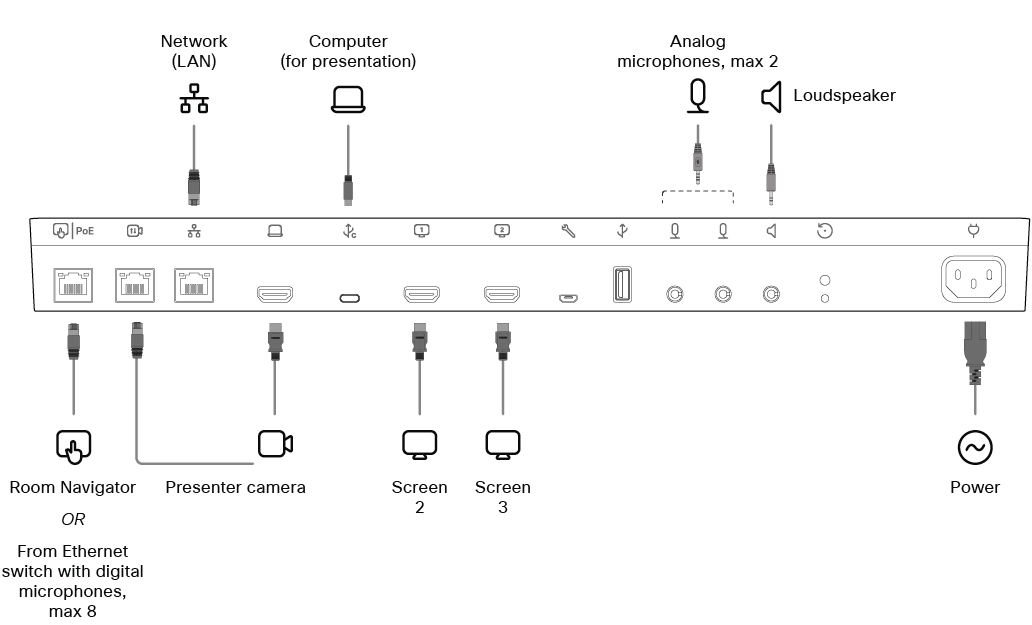
If your room setup has only two screens, integrated and one additional, skip Screen 3.
Codec EQ
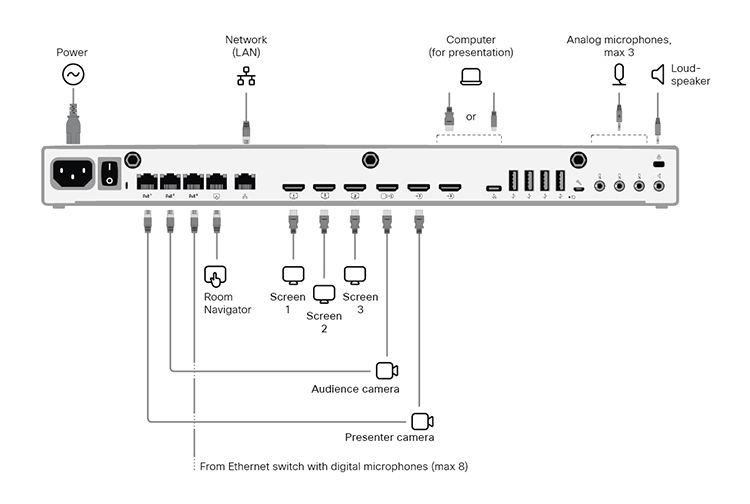
If your room setup has only two screens, skip Screen 3.
Codec Pro
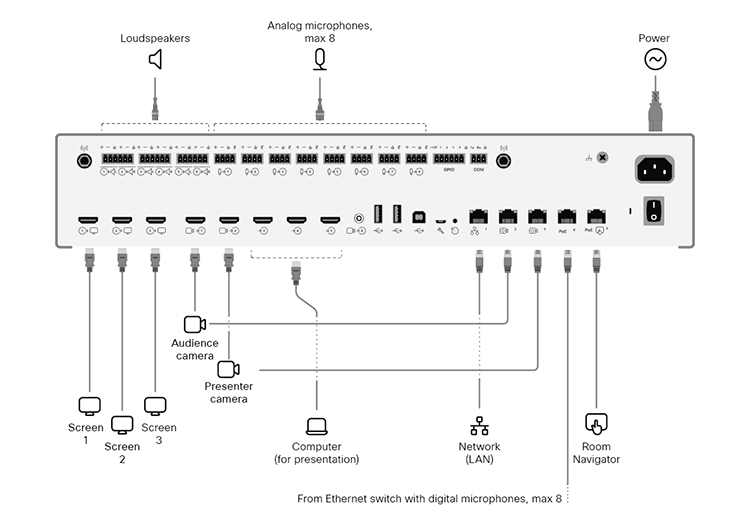
If your room setup has only two screens, skip Screen 3.
Codec Plus
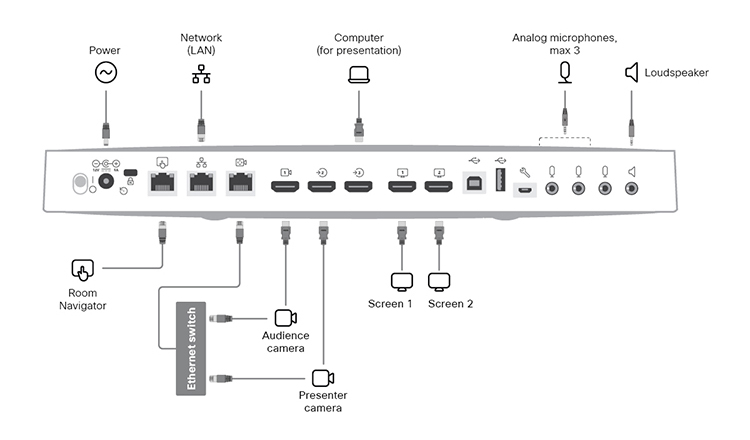
Room Kit EQX
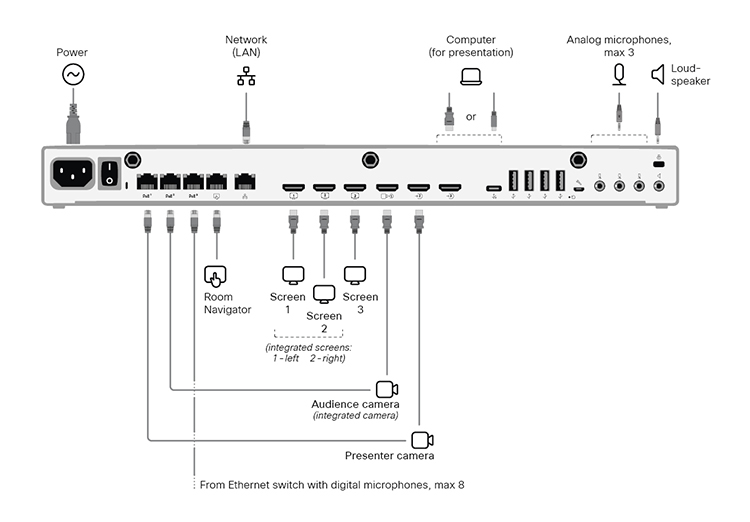
Connect all cables as described in the Room Kit EQX installation guide, including the cables for the integrated camera and screens. In addition, connect the external screens and camera as described here.
External screens and cameras:
-
Screen 3. If your room setup has only two screens, skip Screen 3
-
Presenter camera
Room Bar Pro
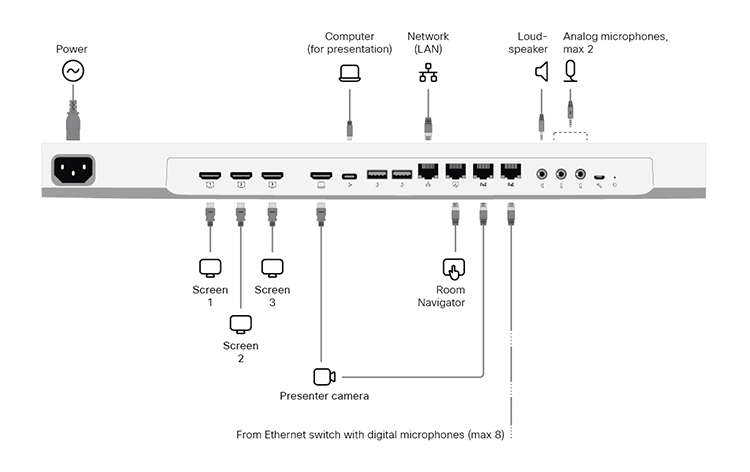
The device's integrated screen is the Audience camera.
External screens and cameras:
-
Screen 3. If your room setup has only two screens, skip Screen 3
-
Presenter camera
Room 70 G2
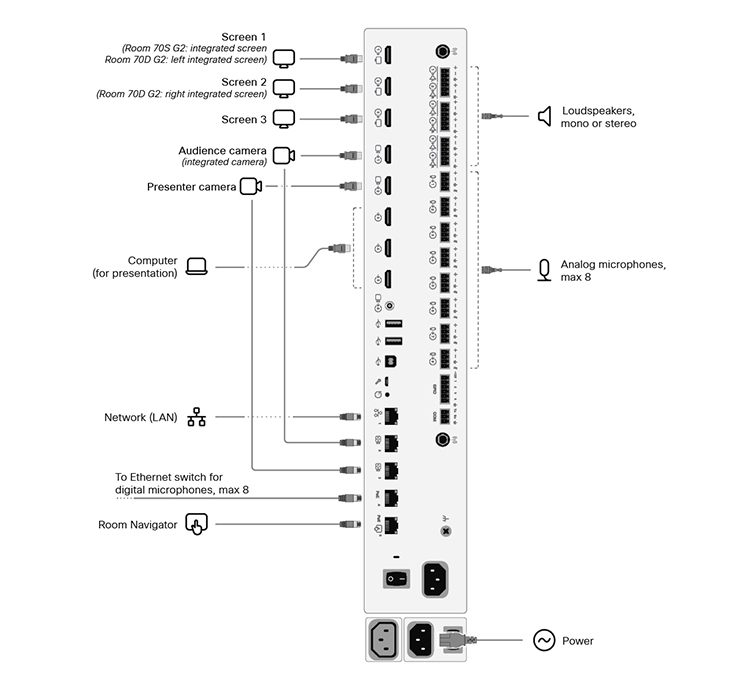
Keep all preconnected cables, including the cables for the integrated camera and screens, as delivered from the factory. Only connect the external screens and cameras.
External screens and cameras:
-
Screen 3 (for Room 70 Single G2 and Room 70 Dual G2). If your room setup has only two screens, skip Screen 3
-
Screen 2 (for Room 70 Single G2)
-
Presenter camera (for Room 70 Single G2 and Room 70 Dual G2)
Room 55 Dual, Room 70 Single, and Room 70 Dual
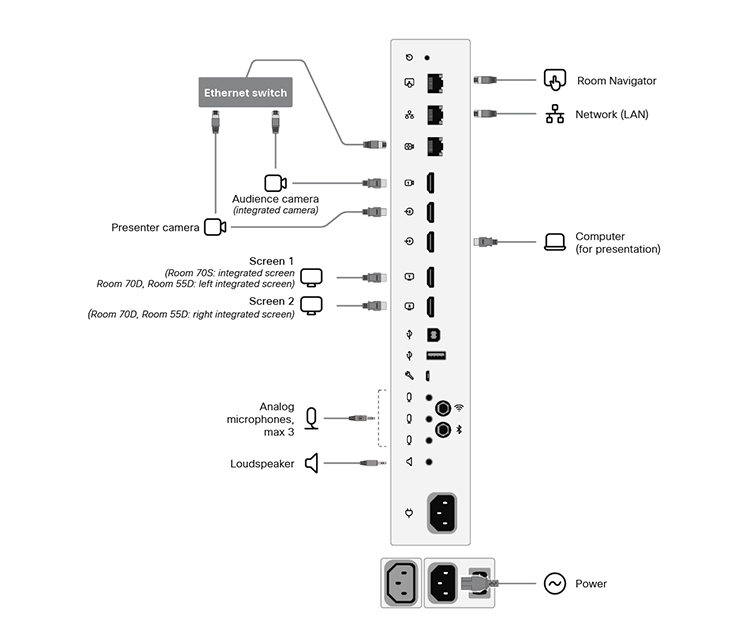
Keep all preconnected cables, including the cables for the integrated camera and screens, as delivered from the factory. You only have to connect the external screens and camera.
External screens and cameras:
-
Screen 2 (for Room 70 Single)
-
Presenter camera (for Room 70 Single, Room 70 Dual, and Room 55 Dual)
Configure the device
We recommend you to be in the same room when setting up Presenter and Audience in your room. Otherwise, it's difficult to set up PresenterTrack properly.
| 1 |
Use the touch controller to stop sharing the video from the presenter camera. It's important that video from the presenter camera isn't displayed on any screen while setting up Presenter and Audience. |
| 2 |
From the customer view in https://admin.webex.com, go to the Devices page, and click on your device in the list. Under Support, click Local Device Controls to open the local device web interface. If you have set up an Admin user locally on the device, you can access the device web interface directly. Open a web browser and type in http(s)://<device ip or hostname>. |
| 3 |
Go to Settings and open the Configurations tab. Then, navigate to the section and set the following (Connector 2 is the connector where the presenter camera is connected):
Click Save for the changes to take effect. |
| 4 |
Go to Settings, open the Audio and Video tab, and click Presenter Track. Then, follow the instructions on the web page to set up the PresenterTrack feature. This feature enables the camera to follow a presenter that is moving about on stage. For more details about setting up PresenterTrack, read the Set up PresenterTrack for Board and Room Series article. |
| 5 |
Go to Settings and open the Room Types tab. Then, click the Presenter and Audience thumbnail to push the corresponding configuration to the device. As a result, there's a Presenter & Audience button on the device's home screen and a Presenter & Audience diagnostics page in its control panel. |
| 6 |
If your setup has more than one microphone, we recommend you specify which ones are covering the stage and which ones are covering the audience. Go to the device's user interface (Room Navigator), open the control panel, and select. Then, for each microphone, tap Stage or Audience depending on its orientation. Not used means that the microphone orientation has no impact on the camera selection logic. It doesn't mean that the microphone itself is disabled. |
Diagnostics
When you’ve pushed the Presenter and Audience set up to the device, you can access the Presenter & Audience diagnostics page from the device user interface. Open the control panel and select .

Microphone orientation configuration
If your room has more than one microphone, some covering the stage and others the audience, we recommend you set the orientation of each microphone.
Tap Microphone orientation configuration in the Presenter & Audience diagnostics page to see the current set-up. To change a value, tap the desired microphone orientation, Stage or Audience. The change is pushed to the device immediately.
Not used means that the microphone orientation has no impact on the decision whether to turn on the audience camera in Auto mode. It doesn't mean that the microphone itself is disabled or not in use.
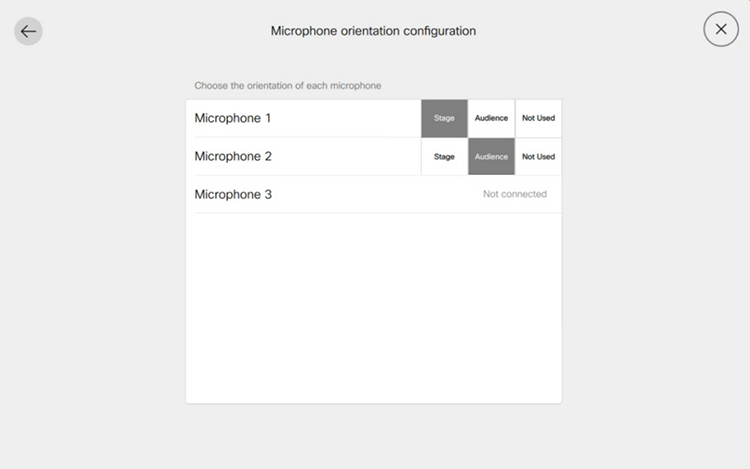
Sound diagnostics
If you've configured at least one microphone to face the stage and at least one to face the audience, VU meters show the current audio volume from the stage and the audience. Otherwise, you get a notification that the microphone orientation is invalid.
The last indicator, Voice detection probability, shows the probability that the picked-up audio signal is a voice and not just background noise.
Example:
-
When the person on stage speaks, you observe a high signal level in the Volume from stage meter and a high Voice detection probability.
-
If the audience applauds, you see the Volume from audience showing high levels. However, the Voice detection probability is low, indicating that it doesn't recognize this as someone in the audience speaking.
-
If someone in the audience starts speaking, both the Volume from the audience meter and the Voice detection probability rise.
The combination of high audience volume and high voice probability triggers the automatic Q&A mode. In this mode, the audience camera is on and uses speaker tracking to focus on the speaker in the audience.
If you add information about the microphone orientation, this automation may be further enhanced. Read more in the Microphone orientation configuration section.
Presenter diagnostics
Presenter status:
-
This field shows if the device detects a presenter on stage (Detected) or not (Gone).
Show trigger zone in selfview:
-
If you toggle on this switch, you see the location of the presenter track trigger zone in the selfview image. This may be useful when troubleshooting issues with local presenter detection. The trigger zone overlay isn't sent to the far end, it’s only shown in the selfview.
Current state:
-
This field shows the current state that the room is in, the main states being Local Presenter, Remote Presenter, or Hybrid Presenter. Other valid states are Local Q and A and Hybrid Q and A, which occur when someone in the audience speaks (asks a question); Noise – No Q and A, which occur when microphones pick up noise from the audience without detecting it as a voice; and Discussion.


